Mariculture is a style of cultivation that involves the cultivation of marine organisms for food and alternative functions within the open ocean, the inside space of the ocean, or in seawater-filled tanks, ponds, or raceways.
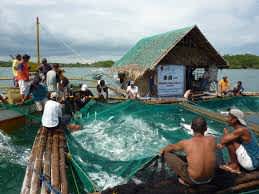
Marine Aquaculture
Seaweeds, mollusks, crabs, fish, and, more recently, echinoderms are among the organisms grown through this technique. Operations range from extensive to highly intensive, as with all forms of aquaculture. Extensive mariculture, on the one hand, is simply based on the protection of the stock to improve wild juvenile survival rates, with few or no nutrients supplied; on the other hand, intensive mariculture may take place in an enclosed system where the farmer provides all nutrients and the environment is maintained through water filtration, sterilization, and oxygenation, as well as the control of light and temperature regimes.
Marine cultivation
Seaweeds, mollusks, crabs, fish, and, more recently, echinoderms are among the organisms fully grown through this system. Operations vary from in-depth to extremely intensive, like all styles of cultivation. On the one hand, in-depth mariculture has just supported the protection of the stock to boost wild juvenile survival rates with few or no nutrients supplied. On the other hand, intensive mariculture could come about in an inside system where the farmer provides all nutrients and the atmosphere is maintained through water filtration, sterilization, and natural action, additionally because of the management of sunshine and temperature regimes.
Why Mariculture?
Mariculture is and can still grow in importance as a supply of aquatic food in coastal areas. as well as a supply of employment and cash for several coastal people. Mariculture that's well-planned and managed can also facilitate guarding the ecology on the coast.
However, in several regions, mariculture's future development is hampered by rising population pressure on coastal resources and inflated competition for resources. As a result, a good deal of focus is needed to boost aquaculture's environmental management through environmentally sound technology and higher management, secured by effective policy and coming up with initiatives and laws.
What is mariculture?
Mariculture is commonly outlined as cultivation in marine environments. Some people believe that mariculture solely refers to the cultivation of marine plants and animals within the water. Others embody species that board saltwater and cultural strategies that come about in salty and salty water that may not be within the ocean. This broader definition is mentioned throughout this section. Mariculture has two factors that distinguish it from capture fisheries: stock possession and active intervention within the production cycle (husbandry).
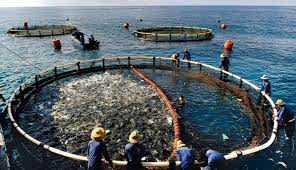
People Active in Mariculture
Sustainable mariculture satisfies food desires by using approaches that may be sustained throughout time. This involves putting the farmed area's water quality in danger and not betting on wild populations to feed or make full use of cultivated species.
Through environmental injury, accidentally released non-native species, or other factors, some styles of mariculture could have an impression on the delivery of advantages in alternative goals. once evaluation of those goals, such things are enclosed as pressures.
Positives of mariculture
Mariculture has the potential to play a major role in food security, economic development, and financial aid, notably in rural areas. In heavily populated coastal locations, mariculture competes for the areas and alternative resources with alternative human activities. Fisheries, tourism, harbor operations, life conservation, and trade are samples of extra activity. Integrated Coastal Zone Management (ICZM) aims to gather various activities within the coastal zone in an exceedingly property-oriented manner. Alternative applications of mariculture are as follows:
Food
Diversification
Finances
Control
Saving existing species
It removes the pressure of fishing
Negatives of mariculture
Mariculture is linked to a variety of environmental problems. Species, culture methodology, stocking density, feed type, farming method, hydraulics website conditions, and also the sensitivity of the receiving atmosphere all play a role in these problems. Several of those problems will be alleviated with the proper solutions. Farmers are typically aware that adequate environmental quality is essential to mariculture's long success. The following are the first sources of negative economic impacts from mariculture:
discharge of effluents that will contain problematic levels of nutrients, antibiotics, or nonnative species;
(2) illness transmission;
(3) use of high levels of provender within the diets fed to the classy species; (4) clearing mangroves from coastal areas; and
(5) predator management measures.
Types of mariculture
Different styles of mariculture are conferred here, consistent with a subdivision by species kind. Different types of species need different|completely different—systems that have different characteristics and effects. Solely the most common systems are mentioned.
Mollusc Culture :
Mollusks are a valuable cluster of shellfish that are harvested on Indian beaches. Their meat is consumed, and also the shell is employed as the stuffing in lime-based industries as well as in the creation of curios. Invertebrate culture, like oysters, clams, mussels, scallops, and abalones, is often practiced in temperate countries to supplement production.
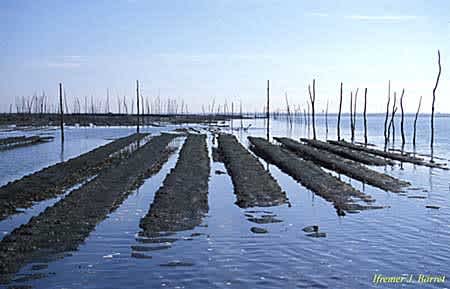
The picture portrays invertebrate culture.
Several invertebrate fanning technologies have been developed in the Asian nation throughout the last twenty years, mostly because of the work of the Central Marine Fisheries Analysis Institute (CMFRI).
Crustacean culture.
Crustaceans are a varied group of arthropods that include crabs, lobsters, crayfish, shrimp, krill, prawns, woodlice, barnacles, copepods, amphipods, and mantis crabs. Some crustaceans have a better relationship with insects and alternative hexapods than alternative crustaceans.
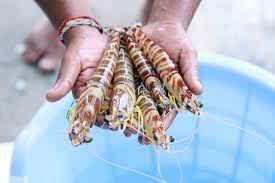
The picture portrays crustacean culture.
The majority of crustaceans are independent aquatic creatures, though some are terrestrial, parasitic, or sessile. The cluster encompasses a long fossil record that dates back to the Cambrian. Fishing and farming turn out over seven million tonnes of crustaceans for human consumption annually, the bulk of which are shrimp and prawns. However, malacostracan crustaceans and copepods aren't usually fished. However, they're among the most biomass-rich organisms on earth, and they play a very important role in the organic phenomenon.
Marine Plant Culture
This includes macro- and microalgae, as well as seagrass.
Young plants are propagated by three different methods: suspended (longline and raft), bottom cultures in the ocean (large rocks or artificial shapes of concrete are placed on the seabed), and upcountry tank cultures.
Finfish Culture
The broodstock will be domesticated or a combination of domesticated and wild animals. Most species are fully grown from larvae or fry made in hatcheries. Spawning is commonly excited with an internal secretion application.
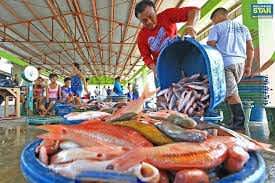
The picture depicts finfish culture
Cage culture can be divided into inshore and offshore cages and can be fixed, floating, or submerged. Inshore cages are located in protected, shallow areas with less water circulation. Offshore cages are located in deep water and open areas with less protection from storms but with better water exchange. Nets and fish pens are located in shallow water and their edges are anchored to the bottom. A typical fish pond system consists of the following basic components: pond compartments enclosed by dikes, canals for supply and drainage of water, and gates or water control structures.
Enhancement or Sea Ranching is mostly developed with marine finfish. Both terms refer to the deliberate release of organisms from hatcheries into the natural ecosystem. In enhancement, fry is released to restock wild populations. In sea ranching, fish are harvested from artificially enclosed areas.
